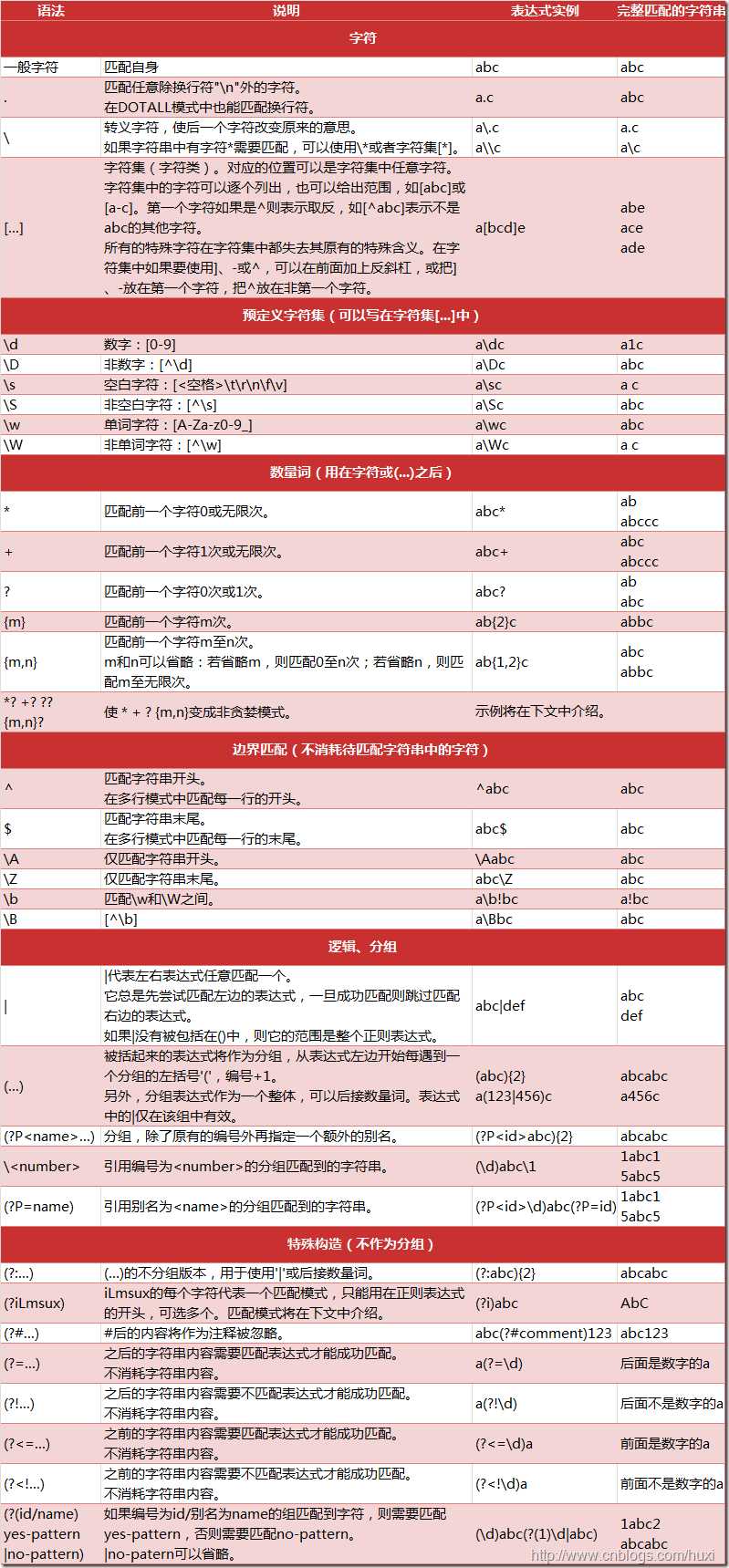标签:
正则表达式并不是python特有的,它在其他编程语言中也有运用到,它不属于任何编程语言,它是独立开来的一种用于处理字符串的强大工具,拥有自己独特的语法。
下面这个图是正则表达式的详细规则

正则表达式通常用于在文本中查找匹配的字符串。Python里当用+?*去匹配的时候默认是贪婪的,总是尝试匹配尽可能多的字符;非贪婪的则相反,总是尝试匹配尽可能少的字符,在+?*后面加个?.例如:正则表达式"xy*"如果用于查找"xyyyz",将找到"xyyyy"。而如果使用非贪婪的数量词"xy*?",将找到"x",像"xy+?",将找到"xy",像"xy??",将找到"x"。
正则表达式也使用"\"作为转义字符,这就可能造成反斜杠困扰。假如你需要匹配文本中的字符"\",那么使用python表示的正则表达式里将需要4个反斜杠"\\\\":前面两个是转义符,后面两个是原义反斜杠,这种格式是python内部的格式要求。而Python里的原生字符串很好地解决了这个问题,这个例子中的正则表达式可以使用r"\\"表示。同样,匹配一个数字的"\\d"可以写成r"\d"。
Python通过re模块提供对正则表达式的支持。使用re的一般步骤是先将正则表达式的字符串形式编译为Pattern实例,然后使用Pattern实例处理文本并获得匹配结果(一个Match实例),最后使用Match实例获得信息,进行其他的操作。

1 # encoding: UTF-8 2 import re 3 4 # 将正则表达式编译成Pattern对象 5 pattern = re.compile(r‘hello‘) 6 7 # 使用Pattern匹配文本,获得匹配结果,无法匹配时将返回None 8 match = pattern.match(‘hello world!‘) 9 10 if match: 11 # 使用Match获得分组信息 12 print match.group() 13 14 ### 输出 ### 15 # hello
re.compile(strPattern[, flag]):
这个方法是Pattern类的工厂方法,用于将字符串形式的正则表达式编译为Pattern对象。 第二个参数flag是匹配模式,取值可以使用按位或运算符‘|‘表示同时生效,比如re.I | re.M。另外,你也可以在regex字符串中指定模式,比如re.compile(‘pattern‘, re.I | re.M)与re.compile(‘(?im)pattern‘)是等价的。
可选值有:

1 a = re.compile(r"""\d + # the integral part 2 \. # the decimal point 3 \d * # some fractional digits""", re.X) 4 b = re.compile(r"\d+\.\d*")
re提供了众多模块方法用于完成正则表达式的功能。这些方法可以使用Pattern实例的相应方法替代,唯一的好处是少写一行re.compile()代码,但同时也无法复用编译后的Pattern对象。这些方法将在Pattern类的实例方法部分一起介绍。如上面这个例子可以简写为:

1 m = re.match(r‘hello‘, ‘hello world!‘) 2 print m.group()
re模块还提供了一个方法escape(string),用于将string中的正则表达式元字符如*/+/?等之前加上转义符再返回,在需要大量匹配元字符时有那么一点用。
Match对象是一次匹配的结果,包含了很多关于此次匹配的信息,可以使用Match提供的可读属性或方法来获取这些信息。
属性:
方法:

1 import re 2 m = re.match(r‘(\w+) (\w+)(?P<sign>.*)‘, ‘hello world!‘) 3 4 print "m.string:", m.string 5 print "m.re:", m.re 6 print "m.pos:", m.pos 7 print "m.endpos:", m.endpos 8 print "m.lastindex:", m.lastindex 9 print "m.lastgroup:", m.lastgroup 10 11 print "m.group(1,2):", m.group(1, 2) 12 print "m.groups():", m.groups() 13 print "m.groupdict():", m.groupdict() 14 print "m.start(2):", m.start(2) 15 print "m.end(2):", m.end(2) 16 print "m.span(2):", m.span(2) 17 print r"m.expand(r‘\2 \1\3‘):", m.expand(r‘\2 \1\3‘) 18 19 ### output ### 20 # m.string: hello world! 21 # m.re: <_sre.SRE_Pattern object at 0x016E1A38> 22 # m.pos: 0 23 # m.endpos: 12 24 # m.lastindex: 3 25 # m.lastgroup: sign 26 # m.group(1,2): (‘hello‘, ‘world‘) 27 # m.groups(): (‘hello‘, ‘world‘, ‘!‘) 28 # m.groupdict(): {‘sign‘: ‘!‘} 29 # m.start(2): 6 30 # m.end(2): 11 31 # m.span(2): (6, 11) 32 # m.expand(r‘\2 \1\3‘): world hello!
Pattern对象是一个编译好的正则表达式,通过Pattern提供的一系列方法可以对文本进行匹配查找。
Pattern不能直接实例化,必须使用re.compile()进行构造。
Pattern提供了几个可读属性用于获取表达式的相关信息:

1 import re 2 p = re.compile(r‘(\w+) (\w+)(?P<sign>.*)‘, re.DOTALL) 3 4 print "p.pattern:", p.pattern 5 print "p.flags:", p.flags 6 print "p.groups:", p.groups 7 print "p.groupindex:", p.groupindex 8 9 ### output ### 10 # p.pattern: (\w+) (\w+)(?P<sign>.*) 11 # p.flags: 16 12 # p.groups: 3 13 # p.groupindex: {‘sign‘: 3}
实例方法[ | re模块方法]:

1 # encoding: UTF-8 2 import re 3 4 # 将正则表达式编译成Pattern对象 5 pattern = re.compile(r‘world‘) 6 7 # 使用search()查找匹配的子串,不存在能匹配的子串时将返回None 8 # 这个例子中使用match()无法成功匹配 9 match = pattern.search(‘hello world!‘) 10 11 if match: 12 # 使用Match获得分组信息 13 print match.group() 14 15 ### 输出 ### 16 # world

1 import re 2 3 p = re.compile(r‘\d+‘) 4 print p.split(‘one1two2three3four4‘) 5 6 ### output ### 7 # [‘one‘, ‘two‘, ‘three‘, ‘four‘, ‘‘]

1 import re 2 3 p = re.compile(r‘\d+‘) 4 print p.findall(‘one1two2three3four4‘) 5 6 ### output ### 7 # [‘1‘, ‘2‘, ‘3‘, ‘4‘]

1 import re 2 3 p = re.compile(r‘\d+‘) 4 for m in p.finditer(‘one1two2three3four4‘): 5 print m.group(), 6 7 ### output ### 8 # 1 2 3 4

1 import re 2 3 p = re.compile(r‘(\w+) (\w+)‘) 4 s = ‘i say, hello world!‘ 5 6 print p.sub(r‘\2 \1‘, s) 7 8 def func(m): 9 return m.group(1).title() + ‘ ‘ + m.group(2).title() 10 11 print p.sub(func, s) 12 13 ### output ### 14 # say i, world hello! 15 # I Say, Hello World!

1 import re 2 3 p = re.compile(r‘(\w+) (\w+)‘) 4 s = ‘i say, hello world!‘ 5 6 print p.subn(r‘\2 \1‘, s) 7 8 def func(m): 9 return m.group(1).title() + ‘ ‘ + m.group(2).title() 10 11 print p.subn(func, s) 12 13 ### output ### 14 # (‘say i, world hello!‘, 2) 15 # (‘I Say, Hello World!‘, 2)
标签:
原文地址:http://www.cnblogs.com/wspcoding/p/5592069.html